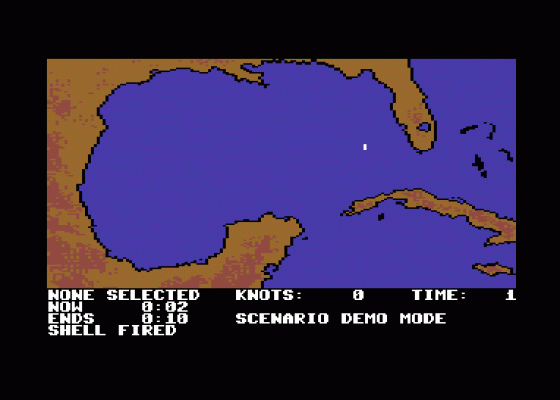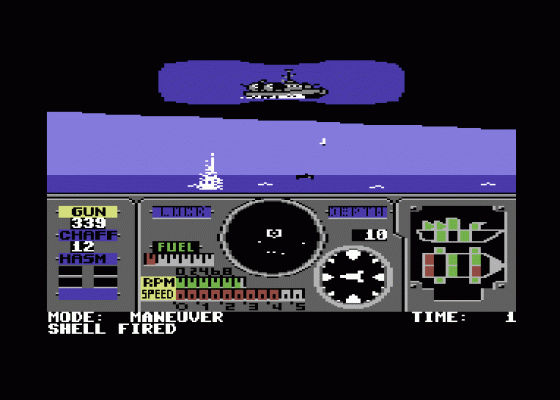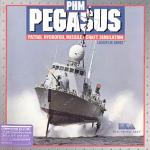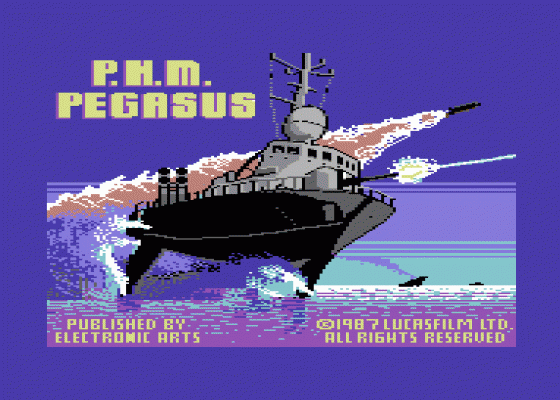
Commodore User
 1st December 1987
1st December 1987
Author: Ken McMahon
Publisher: Electronic Arts
Machine: Commodore 64
Published in Commodore User #51
PHM Pegasus
PHM Pegasus is a patrol Hydrofoil Missile craft simulation. The hydrofoil is the Jetship of the age of all accounts. According to the blurb, it's "so agile, enemy radar mistakes it for a low flying helicopter, so fast, the enemy has only minutes to react". That, of course, depends very much on who's driving the thing. To begin with, I think the enemy were somewhat surprised to find they had hours to react, but the situation didn't last long.
Pegasus is not the kind of simulation that pops up an enemy for you to shoot and destroy and then obliges with another and another and another until you get bored into trying more exciting things like capsizing your own ship or firing on innocent bystanders. Instead, Pegasus offers you eight missions based on 'real-life' scenarios, each of which tests your ability to command and control the hydrofoil's weapons and navigation systems.
The first two scenarios are in fact for training purposes and there's not really any point in going for the more ambitious and exciting missions until you've become accomplished at these. Battle training introduces ten enemy ships into your stretch of water and you have to blow them out of it. The ships appear one at a time so you can just about keep calm, think through what you are doing, and become a really efficient weapon of destruction.

Pegasus operates on two screens, the bridge, where all the action takes place and the operations map, where you can survey a wide area (it takes in continents) and set several courses on the auto pilot. Auxiliary forces can also be controlled from the opeations map. On certain missions, you can make use of two surveillance helicopters. You simply set their destination with the crosswire cursor, set their speed and they get on with it all by themselves. If they spot anything at all it shows as a radar blip on the map. Autopilot can also be set for the hydrofoil, but moving to the bridge and taking joystick control overrides the autopilot.
The bridge is where it all happens, of course. The first contact you will have with enemy ships is when they show up on your radar which has a 40 mile range. For action at close quarters the radar range can be reduced in steps down to 2.5 miles. There are a number of things you can do when you spot an enemy ship, all of which either directly or indirectly involve blowing it out of the water. First, it might be an idea to discover what it is and how dangerous it is, which you can do with the 'ship spotters' guide in the centre pages of the manual (which incidentally is appalling - half of mine was missing!).
There are two ways to blow ships up. The easy way is to let rip with a guided missile and forget all about them. On the bridge there are two modes; manoeuvre and aiming. Manoeuvre means steering (i.e. you can turn left/right, and speed up/slow down). You can also "target" an enemy ship which brings up a closer view in the binoculars at the top of the screen. At this point, pressing the space bar takes you into aim mode, F3 selects the guided missile and I'm sure I don't have to tell you what the fire button does. Guided missiles can take up to about a minute to reach the target depending on its range, but they're pretty reliable.

Smaller patrol boats and ships at close range can be taken out with the 76mm cannon. Same procedure as with the missiles, only this time press F1 for the gun before letting rip. An aim corrector flashes to show where your last shot was wide of the mark so that you can correct accordingly. You have a lot more shells than missiles, so you can really go mad with these.
Of course the enemy doesn't just sit there waiting to be blown up, it (it helps if you try not to think of them as people) fires at you. With shells all you can do is try and dodge, missiles are more fun altogether. A 'lock' indicator tells you when one is on its way in. The procedure is to wait until it is about a mile away, launch the chaff (a sort of mixture of Bacofoil, old Kit Kat wrappers and empty lager cans which fools the enemy radar and deflects missiles) and belt off at right angles. Nine times out of ten you can get away with it, but if you do get hit, damage indicators like the ones you get on the new Fiat Uno dashboard show you what's out of action.
When you get reasonably good at this, you can move on to the graduation exercise, where all ten ships are gunning for you at once. This is good fun, the thing to do is blow them all to pieces as quick as you can. Providing you come up to scratch with the training this should really be no problem, then you can move on to the real thing. The remaining six missions are entitled: Terrorist attack, A better part of valour, Search for terrorists, Supply convoy, Surveillance mission, and JIHAD, which should give you a good idea of what kind of thing this is all about.
For example, Search For Terrorists involves tracking down and destroying two missile corvettes which have attacked an American missile base off the coast of Sicily. You have a Sparviero hydrofoil (armed with Exocets) and an AB212 helicopter to track them down. In all the missions scoring is based on several factors like completion of the main objective (which is not always complete annihilation - there are reconaissance and escort missions), enemies destroyed and time remaining - there is a limit.
As a simulation Pegasus is certainly fascinating to play, it achieves just the right mix of complexity, realism and impressive graphics to keep you hooked. The fact that there is a final objective which must be achieved within the time limit if you are to succeed usually ensures a tension-filled finale. The only think I have to say against it is that, inevitably, the old 'Uncle Ron keeping the free world safe from the gooks, Commies and fanatics' mentality is fairly prevalent. But then, if you are that bothered, you probably wouldn't be interested in war games for a lot of reasons. As wargames go, Pegasus succeeds very well.












